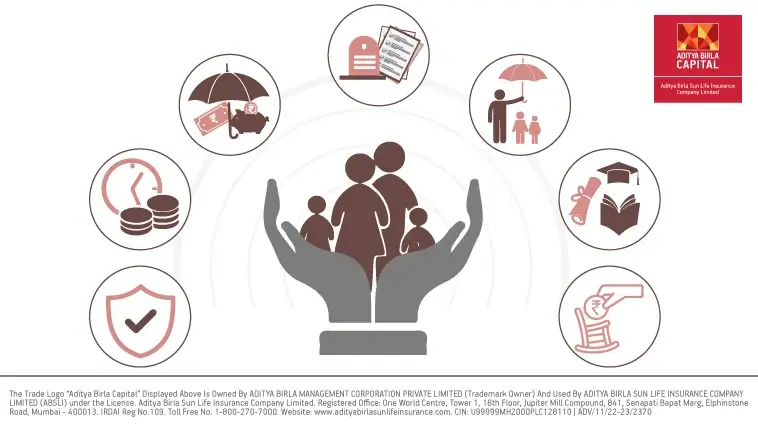Aditya Birla Sun Life Insurance Company Limited
Types of Life Insurance Plans

Plan Smarter, Live Better!

Thank you for your details. We will reach out to you shortly.

Currently we are facing some issue. Please try after sometime.


- Table of Contents
Have you ever wondered why life insurance is often seen as a cornerstone of financial planning? It's because life insurance isn't just about safeguarding against uncertainties – it's also about ensuring peace of mind for you and your loved ones. With so many types of life insurance plans available, understanding each one can help you make an informed decision that aligns with your life goals.
Term Insurance Plan
A Term Insurance Plan is like a straightforward promise – it offers financial protection for a specific period or 'term'. Here's what you need to know about it:
-
Pure Life Cover:
Term insurance provides a death benefit to the nominee if the policyholder passes away during the policy term. -
No Maturity Benefit:
Unlike other life insurance plans, term insurance does not offer any maturity benefit if the policyholder survives the term. -
Lower Premiums:
Since it's a pure risk cover, term insurance plans usually have lower premiums compared to other life insurance products. -
Term Flexibility:
You can choose the term length, which typically ranges from 5 to 30 years, depending on your coverage needs. -
Riders2 Availability:
You can enhance the coverage with riders for additional protection like critical illness, accidental death, etc. Term Insurance is ideal for those seeking affordable, substantial life coverage for a specific period.
Whole Life Insurance Plan
Whole Life Insurance Plan is like a lifelong friend, offering coverage for your entire life. Here’s what sets it apart:
-
Lifetime Coverage:
This plan covers the policyholder until death, irrespective of the age at which it occurs, offering lifelong protection. -
Savings Component:
Apart from the death benefit, it also accumulates cash value over time, which can be a source of savings or loans. -
Higher Premiums:
Due to the lifelong coverage and savings element, premiums for whole life insurance are generally higher than term insurance. -
Dividends:
Some whole life policies pay dividends, which can be received in cash, used to reduce premiums, or left to accumulate interest. -
Flexibility in Payments:
Certain plans offer flexibility in premium payments – you might be able to pay premiums for a limited period but remain covered for life.
Whole Life Insurance is suitable for those looking for lifelong coverage along with an element of savings.
Endowment Plan
An Endowment Plan is a blend of insurance and savings, serving two purposes at once. Here's what makes it special:
-
Dual Benefit:
It provides life coverage along with a savings component. If the policyholder survives the policy term, they receive a lump sum amount as a maturity benefit. -
Fixed Term:
These plans are for a specified term, typically ranging from 10 to 30 years. -
Savings for Future Goals:
Endowment plans are ideal for meeting long-term financial goals like children’s education, marriage, or retirement planning. -
Tax Benefits:*
Premiums paid and the returns (both death and maturity benefits) usually qualify for tax exemptions under prevailing tax laws. -
Higher Premiums:
Due to the savings element combined with insurance cover, the premiums for endowment plans tend to be higher than term plans.
Endowment plans are well-suited for individuals who seek a disciplined savings avenue along with life coverage.
Child Insurance Plan
Child Insurance Plans are designed to secure the financial future of your children, especially in your absence. Key features include:
-
Future Financial Security for Children:
These plans ensure that your children’s future financial needs, such as education and marriage, are taken care of. -
Life Cover and Investment:
Most child plans offer life cover and also invest a part of your premiums in various funds, ensuring growth of your money. -
Waiver of Premium:
Many plans come with a waiver of premium feature, where, in case of the policyholder’s demise, the future premiums are waived off, but the policy continues. -
Payout Flexibility:
They offer flexible payout options, such as lump sum or annual installments, to align with major milestones in a child’s life. -
Tax Benefits:*
The premiums paid and benefits received from child plans are eligible for tax benefits*.
These plans are a great choice for parents looking to ensure their children's financial stability, irrespective of life’s uncertainties.
Money-Back Plan
A Money-Back Plan is a type of life insurance policy that periodically returns a portion of the sum assured during the policy term. Here's how it works:
-
Periodic Payouts:
Unlike endowment plans where the benefit is paid at the end, money-back plans provide periodic payments to the policyholder while still offering life coverage. -
Survival Benefits:
These periodic payouts, known as survival benefits, are a percentage of the sum assured and are paid at regular intervals. -
Maturity Benefit:
On surviving the term, the remaining sum assured (if any) along with accumulated bonuses (if applicable) is paid as a maturity benefit. -
Death Benefit:
In case of the policyholder's demise during the term, the nominee receives the full sum assured regardless of the survival benefits already paid. -
Liquidity: These plans provide short-term liquidity at regular intervals, making them suitable for individuals who need periodic payouts.
Money-back plans are ideal for those who need regular income over the policy term along with insurance cover.
Unit-Linked Insurance Plan (ULIP)
A Unit-Linked Insurance Plan, commonly known as ULIP1, is a multifaceted life insurance product. Here's what you should know:
-
Combination of Insurance and Investment
ULIPs provide life cover while also investing a part of your premium in various market-linked instruments like stocks, bonds, or mutual funds. -
Flexibility in Investment:
You can choose where your money is invested, based on your risk appetite, with options ranging from equity to debt funds. -
Adjustable Life Cover:
You can often adjust the life cover within certain limits during the policy term. -
Long-Term Financial Goals:
ULIPs are suited for long-term financial planning, like retirement or children’s education, due to their investment component. -
Tax Benefits:*
Premiums paid towards ULIPs are eligible for tax deductions, and the maturity proceeds are also generally tax-free. -
Lock-In Period: ULIPs have a minimum lock-in period, usually of five years, which encourages long-term investment.
ULIPs are ideal for those who want to combine the benefits of life insurance with the growth potential of market investments.
Group Insurance Plan
Group Insurance Plans offer coverage to a group of people, typically employees of an organization or members of a society. Here’s how they work:
-
Collective Coverage:
These plans provide life insurance cover to all members of the group under a single policy. -
Employer-Employee Benefit:
In an organizational setup, it's a part of employee benefits. The employer often bears the premium costs, either wholly or partially.
3 . Lower Premiums:
Due to the collective nature, the premiums are generally lower compared to individual insurance policies.
-
Uniform Coverage:
Coverage amount is generally the same for all members, though it may vary based on the member's rank or salary in an organization. -
No Medical Examinations: Typically, group insurance plans don’t require individual members to undergo medical examinations.
Group Insurance Plans are beneficial for providing a basic level of insurance cover to a large number of people at an affordable cost.
Retirement Plan
Retirement Plans, also known as Pension Plans, are designed to provide financial security in your golden years. Key aspects include:
-
Regular Income Post-Retirement:
These plans aim to provide a steady income stream after you retire, ensuring financial independence. -
Accumulation Phase and Vesting Phase:
The policyholder pays premiums during their working years (accumulation phase), and upon retirement, the plan starts paying out (vesting phase). -
Variety of Plans:
Retirement plans come in various forms, including immediate annuity plans where you pay a lump sum and start receiving pension immediately, or deferred annuity plans where the pension starts after a certain period. -
Tax Benefits:*
Contributions made towards retirement plans are eligible for tax deductions under Section 80C, and the pension received may also have tax benefits*. -
Lump-Sum and Annuity Options: Upon retirement, most plans offer a choice to withdraw a lump sum and/or receive a regular annuity/pension.
Retirement Plans are essential for anyone looking to secure their financial future post-retirement, providing peace of mind and a stable income.
How to Choose the Right Type of Life Insurance Policy?
Choosing the right life insurance policy can be a bit like finding a suit that fits you perfectly—it needs to match your lifestyle, financial goals, and the needs of your loved ones. Here are some steps to guide you through the process:
-
Assess Your Financial Goals:
Are you looking for protection, savings, investment returns, or retirement planning? Your goals will dictate the type of policy you need. -
Consider Your Life Stage:
A young single professional might have different insurance needs compared to a married individual with children. -
Evaluate the Coverage Amount:
How much financial support will your family need in your absence? Consider liabilities, future expenses like children's education, and your income. -
Understand Different Plans:
Research the features, benefits, and limitations of various life insurance policies like term insurance, whole life, ULIPs, etc. -
Consider the Premiums:
Choose a plan with premiums that you can comfortably afford now and in the future. -
Review Additional Benefits and Riders:
Look for add-ons like critical illness riders or accident benefits that can enhance your insurance coverage. -
Read the Fine Print:
Understand the policy terms, conditions, exclusions, and the claim process. -
Seek Professional Advice: If you're unsure, consult with a financial advisor who can provide personalized advice based on your financial situation and needs.
Final Thoughts
Life insurance is more than just a financial product; it's a commitment to protect and provide for those who matter most to you. From safeguarding your family's future in case of your untimely demise to planning for a comfortable retirement, the right life insurance policy can make all the difference. Whether it's the simplicity of term insurance, the longevity of whole life insurance, the flexibility of ULIPs, or the security of a retirement plan, each type of life insurance serves a unique purpose. By carefully considering your personal needs, financial objectives, and the different options available, you can choose a policy that not only offers peace of mind but also aligns seamlessly with your life journey. Remember, the best life insurance policy is the one that works for you and your family, ensuring that your loved ones are protected, come what may.
Thanks for reaching out. We will reach out to you shortly.
Thanks for reaching out. Currently we are facing some issue.
Get immediate income payout after 1 day of policy issuance^
ABSLI Nishchit Aayush Plan
Guaranteed# Income
Life Cover across policy term
Lumpsum Benefit at policy maturity.
Get:
₹33.74 lakhs~
Pay:
₹10K/month for 10 years
Most Popular Calculator
Guaranteed returns after a month¹
*Tax benefits are subject to changes in tax laws. Kindly consult your financial advisor for more details
1In the Unit Linked Policy, the investment risk in the investment portfolio is borne by the Policyholder.
2Riders offer additional benefits that are not included in the base policy at a nominal additional premium. There are exclusions attached to the riders. Please refer prospectus for more details.
ADV/2/23-24/3562







